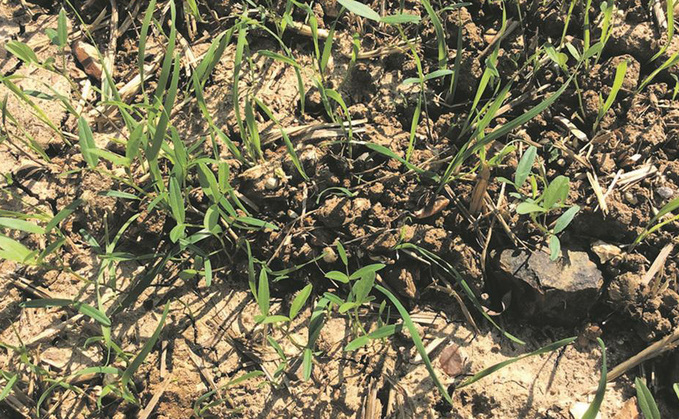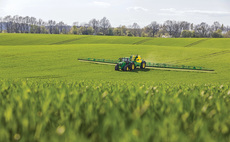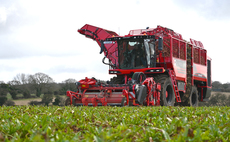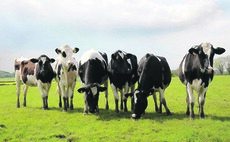
Weed pressure will be a mixed bag this season after many winter crops missed pre-em treatments, but those late drilling can get ahead of the game with early control.
Where winter cereals went in very late into the New Year, and received a pre-emergence herbicide, weed pressure is expected to be very low, says Tod Hunnisett, independent agronomist, who covers land from Wiltshire to East Kent.
"Pre-ems have worked very well indeed because shortage of moisture certainly hasn't been a problem," he says.
However, a considerable amount of drilled cereals will not have received a pre-em due to the wet conditions, and this is where black-grass is likely to be worst, says Mr Hunnisett.
"In situations like that the weed burden is going to be very high and we'll be relying on post-emergence contact materials to control them.
"If there are grass-weeds like black-grass, I'll be going down the Atlantis/Pacifica route. Pacifica has a certain degree of effect on some broad-leaf weeds. If there are other broad-leaf weeds like groundsel and mayweeds I will add something to the Atlantis to take the broad-leaf weeds out. Quite often this will be Atlantis + Ally or Ally Max mix. This is a pretty comprehensive mixture for taking out the grass-weeds and broad-leaf weeds that are there."
Where pre-ems were applied but weeds are still coming through, or crops haven't had a pre-em, but black-grass is not a problem, Mr Hunnisett recommends Ally Max + fluroxypyr with a wild oat herbicide if necessary.
He adds: "There are some situations where weeds have now emerged pre-drilling which will get glyphosate. This means the pre-ems that go on have a good chance of doing a pretty comprehensive job.
"In situations like that, there may be some knocking-off cleavers later on in the season, but I don't see early weed control as being a problem."
Competition
However, it is not just lack of herbicides that might hinder weed control this spring, with many drenched crops only managing minimal growth, leaving them open to competition.
This is another reason that the potential for more grass-weed and broad-leaved weeds is much greater this spring, says Adam Espir, regional agronomist at FMC.
"Because of the cold and especially wet autumn, crops have also been very slow to come through and they're very open, much more so than normal. That leaves a larger area for weeds to germinate."
But with an exceptionally busy season ahead for the many trying to play catch-up after a disastrous autumn, herbicides are unlikely to be top priority, he adds.
"Growers' priorities will be to drill wheat rather than go on with herbicides if the conditions are right, meaning there will most likely be more broad-leaf and grass-weeds than in a normal year."
Without residual herbicides in place, weeds will also be appearing earlier than normal, so March will be a key month for both grass- and broad-leaf weed control, he says.
However, with 2018's Beast from the East still in recent memory, growers must be mindful of going in too early in cold conditions.
Mr Espir says: "Jubilee, Ally Max and Harmony M will be our three main products, and because there'll be more broad-leaf weeds, those products may be applied in March, rather than April time.
"These work best when the weeds are actively growing so if you get a very cold March, these products won't work very well."
There are likely to be other inputs tank mixed this spring, including crop nutrition and fungicides, Mr Espir advises. "SUs are very flexible and can be used in a lot of different tank mixes - it's best to check with the manufacturer.
"This will not be a normal year and many growers are in a very unusual circumstance. They will need to speak to their agronomist more than ever about the best steps to take."
Good control is all in the timing
For other grass-weeds including wild oats, rye-grasses and brome, Corteva's Alister McRobbie says timing will be key.
"For Broadway Star it is essential that growers get the timing right because it is an ALS, which means it needs to be applied to an actively growing weed. If the grass-weed isn't growing, the ALS won't work."
Mr McRobbie adds that soil temperature should be greater than 6degC and the seven day mean air temperature needs to be at least 8degC.
He says: "Weeds need to be actively growing two-three days prior to that, post-application weather conditions should be that that weeds will keep growing after application as well."
With residual stacks having no impact on certain weeds, Mr McRobbie warns that there are likely to be some very large cleavers come spring.
He says: "We might also get large, over wintered poppies, and other autumn germinating weeds like cranesbill, fumitory, and groundsel. In that scenario I recommend growers apply a robust programme, including Pixxaro or Zypar in tank mix with an SU herbicide to complete the broad-leaf weed spectrum."
With many crops going into poor seedbeds, as clods breakdown in the spring, more grass and broad-leaved weeds are likely to emerge, meaning spring emergence is protracted, says Mr McRobbie.
"We're also going to get more spring cereals, which will bring different challenges especially if poor weather continues. The likelihood is that spring cereals will go in in a situation where you might have large, over wintered weeds because nothing has been sprayed in the autumn, so weeds like cleavers and poppies will have been growing, and there will be small spring germinators arriving at the same time."
This will make application timing tricky, and growers may need to use higher use rates than normal to tackle the large weeds, Mr McRobbie adds.
"Pixxaro or Zypar will need to be tank mixed with an SU herbicide to complete the weed spectrum and control some of these umbelliferous weeds that are around like bur chervil.
"The other thing you need to be mindful is there will be a lot of bean volunteers which halauxifen will be good at controlling, and OSR and potato volunteers, which is where you need help from sulfonylurea herbicides."
Bur chervil threat
One weed being seen more regularly throughout the major arable areas is bur chervil. The headland weed, which is related to cow parsley and hemlock germinates in the autumn and grows very rapidly in the spring, says Adam Espir.
"Most products aren't so great on this weed and they need an SU herbicide - Harmony M or Ally Max are very good at controlling them. Our advice is to go on early when the weed is small, in March to get on top of the problem. If you wait until T1 which is typically April 20, the weed can be very large. It grows so fast that it swamps the crop. It's a real problem and now I get more questions about this weed than anything else."
Actives:
Ally, Harmony M and Jubilee - metsulfuron
Ally Max - metsulfuron + tribenuron
Atlantis and Pacifica - mesosulfuron + iodosulfuron
Broadway Star - pyroxsulam + florasulam
Pixxaro - Arylex - halauxifen + fluroxypyr
Zypar - Arylex + florasulam






















